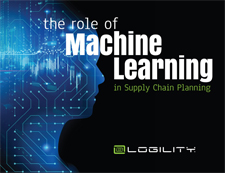The Thin Supply Chain Line
Most of you have probably heard the term "the thin blue line."
Today, it has entered the common US vernacular to mean the role played by the nation's police as "the barrier between law and order and social and civil anarchy," according to Wikipedia.
Its origins are unclear, but it is believed the phrase was first used in that context by then chief of the Los Angeles police department Bill Parker in the 1950s.
| GILMORE SAYS: |
The thin supply chain line is vulnerable in part because of the very success of supply chain practice in reducing inventories.
WHAT DO YOU SAY?
Send us your
Feedback here
|
With the coronavirus crisis, what we now have is a "thin supply chain line." That line, precariously thin right now I am afraid, is indeed serving as the barrier between law and order and social and civil anarchy every bit as much as the police - who might be needed later if the supply chain line fails.
But not only between law and order and civil anarchy. Supply chain also is serving as a barrier between life and death in the medical supply chain.
Most SCDigest readers will know what I write below, but it is worth articulating nevertheless, at a time when "supply chain" is rolling off the tongues of politicians on television and radio left and right. Never before has the discipline received such recognition.
As I pen these words, almost everywhere the US supply chain for what I will call "staples" - food and beverage, most consumer packaged goods, etc., is holding up remarkably well - with the noticeable exception of toilet paper, of course, and some cleaning products like disinfectant wipes. There are more limited shortages depending on market area and individual store in items from chicken breasts to frozen pizza, but in general, for now, most items can be fairly reliably be found.
It is a complex choreography of sourcing, inbound logistics, production, outbound logistics, and store fulfillment to make that happen.
And right now, there are risks at every one of those steps in the chain.
Let's start with sourcing. In many product categories, finished goods and ingredients are heavily sourced internationally, whether it's a chemical that goes into laundry detergent or fresh produce from Mexico.
We know Chinese production has been seriously compromised, with very few factories in some areas back to full capacity and workforce availability still low.
That in itself may still cause serious issues with supply. The virus could of course next hammer production in sourcing points outside of China, as has already occured through most of Europe. What if there come some instance of someone becoming infected as a result of an imported product or ingredient? Consumer rejection of imported food stuffs could be swift and severe, depending on the details.
A report Wednesday said some countries were starting to hoard foodstuffs and stop exports.
Manufacturing is also at risk. Reports are that some manufacturers are already going through hoops to find ways to isolate workers to avoid an infected employee from passing it on to others. Good luck.
But surely that will happen, and likely has already done so. How could it not have? And what happens at the factory when a worker has caught the virus? Is the plant shut down? For how long - against what protocol for reopening?
The thin supply chain line is vulnerable in part because of the very success of supply chain practice in reducing inventories. In the food industry, those inventories not long ago were measured in months' worth of sales. Now for most it is like 4 to 6 weeks.
So when demand surged at the start of the crisis, CPG manufacturers had to scramble, with some reportedly making real-time sourcing and production decisions on the fly without the careful orchestrated supply planning most have become dependent on.
They are also getting creative. The Wall Street Journal reports that General Mills is shipping large quantities from plants direct to retail stores, not the retailers' distribution centers, to take some time out of the stores replenishment cycle.
Let's move on to distribution. I have heard of one 3PL facility that had an infected worker and was forced to close down that warehouse - for how long it is unclear.
Then there were solid news reports that last week, workers for a shift at an Amazon fulfillment center in Queens, New York were sent texts saying not to report due to a worker on a previous shift being confirmed as infected.
The details are unclear what happened after that, but it appears the facility was opened the next day after a thorough cleaning - though exactly you thoroughly clean a million square foot-plus FC I am not quite sure. As I write this, 10 Amazon US FCs have seen workers with infections. The approach seems to vary, with one said to have closed the facility for as long as 48 hours, with deep cleaning, before opening back up. Others are stopping work for much less. It's obvious there is no standard to look to.
Then there is the trucking - hundreds of thousands of drivers riding largely solo, hours and hours at a stretch, bringing the goods to DCs and stores, a process about which nearly all consumers really have no idea.
I referenced last week a talk radio call in Cincinnati from a trucker saying it was increasingly difficult to find food on the road - and how when he found a McDonald's drive-thru too small of course for his rig, it an employee wouldn't let him walk through due to a store policy that customers must be in a vehicle.
He lucked out when the person in the car behind him bought his lunch.
 You may also have seen that the US Dept. of Transportation has relaxed Hours of Service rules to increase the flow of goods - rules issued in the name of safety, which now relaxed simply allow truckers to spend more time on the road with fewer breaks. All told, probably a smart thing. You may also have seen that the US Dept. of Transportation has relaxed Hours of Service rules to increase the flow of goods - rules issued in the name of safety, which now relaxed simply allow truckers to spend more time on the road with fewer breaks. All told, probably a smart thing.
A great organization called "Trucking Moves America Forward," which exists to improve the image of trucking and drivers in the US, notes on its web site that 'Most Americans don't realize how essential trucks are to their lives until there is a severe weather or adverse condition that prevents trucks from delivering," adding that "the fact is trucks are critical to our national and global economy, to our families, to our businesses, and so much more. When they stop moving, the country stops moving."
No doubt. And that's in normal times. We are in extraordinary times.
I don't have room other than to note the supply chain's life saving role in producing and distributing new face masks, ventilators and other key health care items that will save lives.
So I ask: What happens when truck stops have affected workers and have to close, keeping truckers from refueling, getting minor repairs, finding a carry out meal?
What happens when grocery store employees are infected? Does the store close? For how long? Does everyone who shopped have to be quarantined?
Last week, The Atlantic magazine, in a story about the Amazon DC closure, included this observation: "It's unclear how deliveries could continue if the workers who sort, pack, and ship Americans' goods start getting sick in droves."
Very unclear indeed. I only know it will be very terrible -and the thin supply chain line will breached, with predictable and scary results.
What are you thoughts in the "thin supply chain line?" Is it the right term for the times? Let us know your thought at the Feedback button below.
|











 You may also have seen that the US Dept. of Transportation has relaxed Hours of Service rules to increase the flow of goods - rules issued in the name of safety, which now relaxed simply allow truckers to spend more time on the road with fewer breaks. All told, probably a smart thing.
You may also have seen that the US Dept. of Transportation has relaxed Hours of Service rules to increase the flow of goods - rules issued in the name of safety, which now relaxed simply allow truckers to spend more time on the road with fewer breaks. All told, probably a smart thing.


